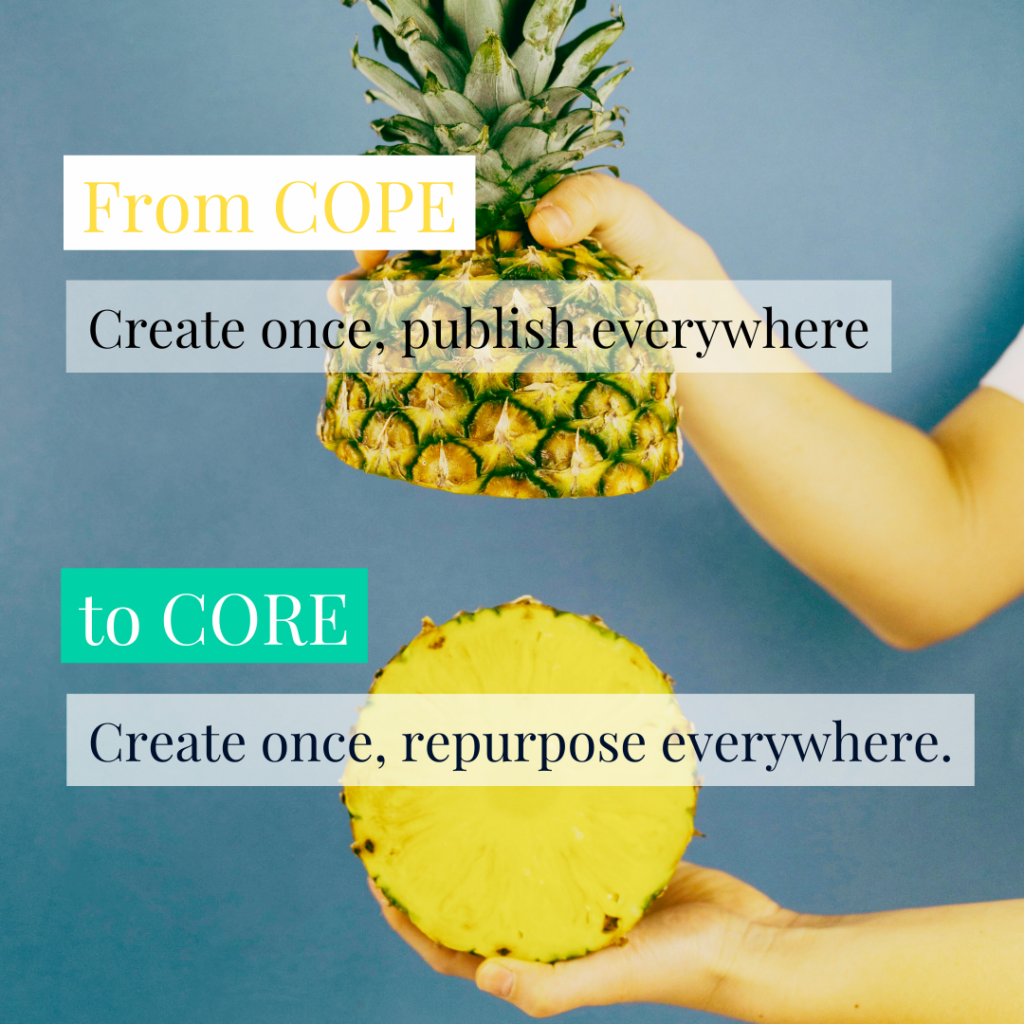Our take on COPE – Create Once, Publish Everywhere
Are you leveraging your content to its full potential? Most marketers aren’t. By repurposing and optimising your work across various platforms, you ensure broader reach and better engagement with minimal effort.
SIGN UP FOR OUR NEWSLETTER
Writing great content is no walk in the park. If you spent weeks slogging away trying to write an article – or used up precious budget to have a copywriter do it for you – it can be tempting to hit publish and move on to the next item on the list.
But here’s the truth. If you rely on SEO alone to drive readers to your new article or hope that they miraculously stumble upon it while checking out your website, you‘re seriously limiting the success of your content.
If you want to squeeze every drop of goodness from your content, it’s time to invest in a COPE strategy.
What is a COPE strategy?
COPE stands for Create Once, Publish Everywhere. The concept was founded by National Public Radio (NPR), an American non-profit media company responsible for some seriously great digital content (if you haven’t seen the Tiny Desk Concerts, consider it essential viewing).
COPE emerged as a clever way to create and manage content in one place while distributing it *everywhere*. This was possible through the use of APIs that could deliver content to multiple endpoints, as long as it was structured in the right way.
This was a massive time saver – and it’s still widely used across CMS platforms with loads of benefits. For example, global modules are a type of COPE feature that let you update info or drop in content in one spot, and the API pushes it out on every page. This is typically used for website footers that need to be the same on every page, and it’s increasingly used for content like ads, podcasts and sign-up forms.
But COPE goes beyond updating your website. It allows you to publish content across multiple sites, platforms and channels. And some CMSs are sophisticated enough that they can even make small tweaks to the content based on the channel’s parameters.
But as copywriters, we know that multi-channel publishing is an art. Content that shines on one channel might flop on another. Which is why optimising for different platforms and audiences is critical.
From COPE to CORE
We’ve developed multichannel content for loads of brands – including UNSW, dusk and Dermal Therapy. And we know from experience that contextualising content for different platforms and audiences is make or break. That’s why we love the adapted CORE approach – Create Once, Repurpose Everywhere.
With a CORE strategy, anything you spend precious time or budget creating is carefully repurposed for all (or at least a bunch of) your available channels. Brandingmag uses a similar approach if you want to check out their take on it.
CORE is how your humble blog reaches people on every platform. It’s how you maximise your marketing efforts and engage your audience across every medium.
Why is CORE such a game-changer?
Save time: We see you, marketers. We know you’re busy as hell. CORE is a great way to make sure the time and effort you dedicate to a piece of content delivers the absolute maximum value.
Expand your reach: Don’t let your brilliant article gather dust on a blog with little traffic. Sharing it on different channels and in different formats ensures it gets the eyeballs it deserves.
Make it relevant: The CORE approach lets you customise, repurpose and reposition the original content in a way that’s relevant to the audience and the platform. The more relevant and contextualised the content, the more likely you are to get their attention.
The CORE method
Here’s what the CORE process looks like in action.
Step 1 – Content ideation: Start with a versatile core idea.
Step 2 – Creation: Focus on adaptable and modular content that is (ideally) evergreen.
Step 3 – Adaptation: Tailor your content for different platforms, including social media, blogs, email newsletters and direct comms. Consider how your brand voice flexes across different channels.
Step 4 – Distribution: Use scheduling tools to save time publishing your content.
Step 5 – Measurement: Don’t publish and forget. Track the performance of each piece of content and optimise accordingly.
If you’d like to adopt the CORE method for your brand but aren’t sure where to start, our gun in-house strategy team can help. Say hello.
You may also like
Healthcare content for humans: The case for saying it like it is
Why healthcare content should be helpful and human – not filled with jargon.
READ MOREAI brainstorming: A new approach to ideation
AI brainstorming is a game-changer for idea generation. Learn why leveraging tools like ChatGPT for
READ MORE
